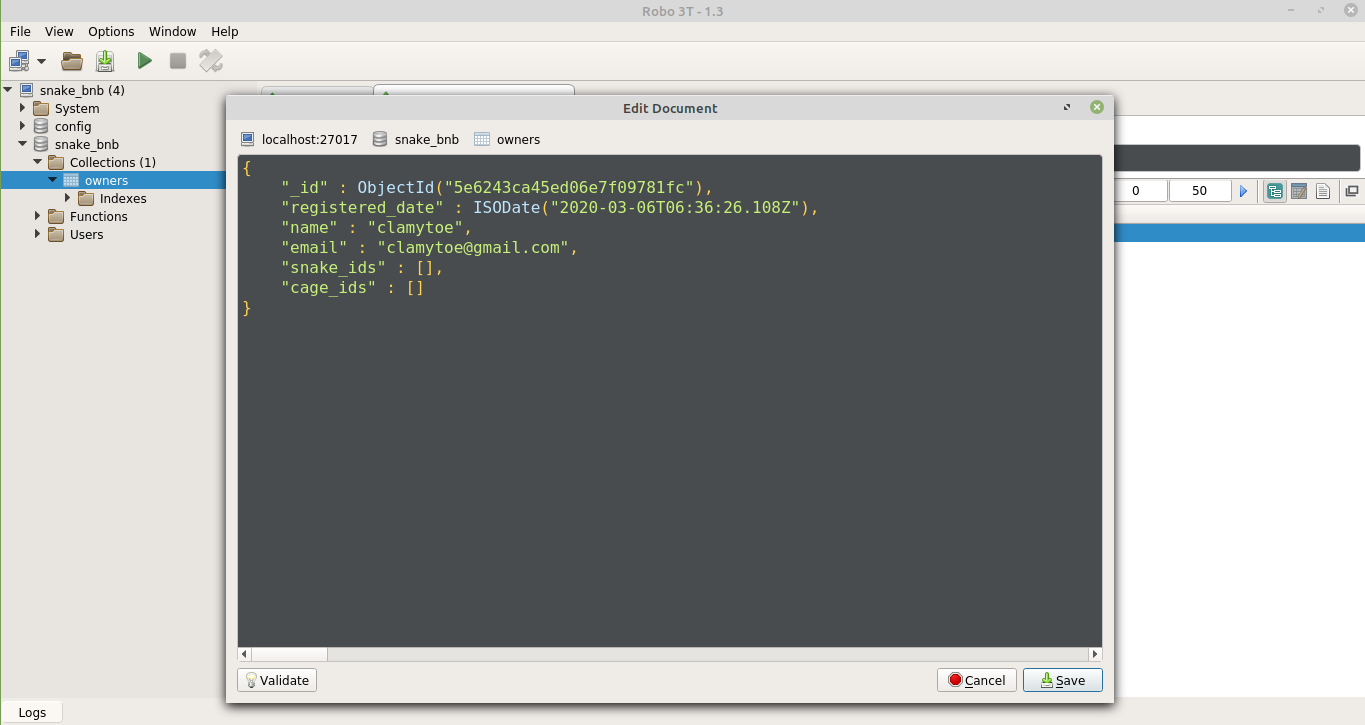Why another article on MongoDB
After publishing my article on How to install MongoDB on Linux I realized that I should have covered how to access it through the command line! Didn't occur to me that anyone reading it might not want to download and install Robo 3T!
Sorry about that!
Intro into the mongo cli app
It's simple enough. Now I'm no expert but this is what I discovered just playing around with it.
(base) ➜ ~ mongo
MongoDB shell version v4.2.3
connecting to: mongodb://127.0.0.1:27017/?compressors=disabled&gssapiServiceName=mongodb
Implicit session: session { "id" : UUID("39eaf67e-7de5-4874-ba3e-a6673080cfbc") }
MongoDB server version: 4.2.3
Welcome to the MongoDB shell.
For interactive help, type "help".
For more comprehensive documentation, see
http://docs.mongodb.org/
Questions? Try the support group
http://groups.google.com/group/mongodb-user
Server has startup warnings:
2020-03-06T20:35:19.314-0600 I STORAGE [initandlisten]
2020-03-06T20:35:19.314-0600 I STORAGE [initandlisten] ** WARNING: Using the XFS filesystem is strongly recommended with the WiredTiger storage engine
2020-03-06T20:35:19.314-0600 I STORAGE [initandlisten] ** See http://dochub.mongodb.org/core/prodnotes-filesystem
2020-03-06T20:35:22.538-0600 I CONTROL [initandlisten]
2020-03-06T20:35:22.539-0600 I CONTROL [initandlisten] ** WARNING: Access control is not enabled for the database.
2020-03-06T20:35:22.539-0600 I CONTROL [initandlisten] ** Read and write access to data and configuration is unrestricted.
2020-03-06T20:35:22.539-0600 I CONTROL [initandlisten]
---
Enable MongoDB's free cloud-based monitoring service, which will then receive and display
metrics about your deployment (disk utilization, CPU, operation statistics, etc).
The monitoring data will be available on a MongoDB website with a unique URL accessible to you
and anyone you share the URL with. MongoDB may use this information to make product
improvements and to suggest MongoDB products and deployment options to you.
To enable free monitoring, run the following command: db.enableFreeMonitoring()
To permanently disable this reminder, run the following command: db.disableFreeMonitoring()
---
>
As you can tell, I haven't secured the database yet. Let's continue exploring though and see what the help command will show us.
> help
db.help() help on db methods
db.mycoll.help() help on collection methods
sh.help() sharding helpers
rs.help() replica set helpers
help admin administrative help
help connect connecting to a db help
help keys key shortcuts
help misc misc things to know
help mr mapreduce
show dbs show database names
show collections show collections in current database
show users show users in current database
show profile show most recent system.profile entries with time >= 1ms
show logs show the accessible logger names
show log [name] prints out the last segment of log in memory, 'global' is default
use <db_name> set current database
db.foo.find() list objects in collection foo
db.foo.find( { a : 1 } ) list objects in foo where a == 1
it result of the last line evaluated; use to further iterate
DBQuery.shellBatchSize = x set default number of items to display on shell
exit
>
Ok, looks simple enough. That show dbs sounds interesting.
> show dbs
admin 0.000GB
config 0.000GB
local 0.000GB
snake_bnb 0.000GB
>
Ok, I see the snake_bnb database that we created during the MongoDB Quickstart tutorial.
Let's see what's in it with that use <db_name> command, followed by show collections.
> use snake_bnb
switched to db snake_bnb
> show collections
owners
>
Now if I reference the help command again, I see that I can use db.foo.find() to do a dump of everything in it.
> db.owners.find()
{ "_id" : ObjectId("5e6243ca45ed06e7f09781fc"), "registered_date" : ISODate("2020-03-06T06:36:26.108Z"), "name" : "clamytoe", "email" : "clamytoe@gmail.com", "snake_ids" : [ ], "cage_ids" : [ ] }
>
If I had more entries, it looks like I could search for specific entries with db.foo.find( { a : 1 } ).
I only have one record, so I should just get the same result as the previous command.
> db.owners.find( {"name": "clamytoe"} )
{ "_id" : ObjectId("5e6243ca45ed06e7f09781fc"), "registered_date" : ISODate("2020-03-06T06:36:26.108Z"), "name" : "clamytoe", "email" : "clamytoe@gmail.com", "snake_ids" : [ ], "cage_ids" : [ ] }
>
To exit, we just use the exit command.
> exit
bye
(base) ➜ ~
Conclusion
There you have it. A quick intro into using the mongo cli app. Simple enough for quick exploration of your databases. I'll probably be spending more time in Robo 3T though. Not only can your explore the databases through a GUI, but you can also easily add, delete, and update and entries with it.
